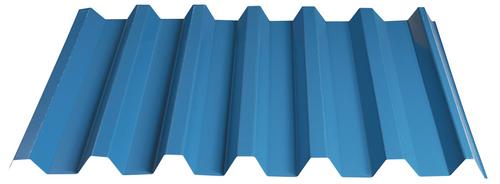Maintenance and storage of goods
The sheets are unloaded from transport onto a base in the construction site, which is a dais at least 20cm high from the ground and is made of cross girders placed at least meter?s distance from behind. It is advisable to transport sheets with derrick crane car. The sheets are generally packaged in the factory and are therefore easily liftable with the crane and frame. If no crane at your disposal, lift the sheets one by one. At this point, one should avoid the friction of sheets – they should be lifted, not pulled! The sharp cut edges of sheets can damage the finished coating of an underneath sheet.


In case of factory transportation, check immediately if there are any defects, possible omissions and damages, of which you should IMMEDIATELY inform the sales office of AS Toode. The signature of the person receiving the goods is binding, posterior claims are not considered. Each client has the right to be provided with AS Toode warranty terms and conditions on paper carrier. Do not use defective products!
Thin steel sheets may bend slightly, which is why they are to be handled with caution. Besides, the sheets are easily stretched. Sheets cannot be lifted being held by the two ends only! The sheets can be lifted to the roof using stable support beams and lifting these at many places. Possible scratches and other surface coating defects are removed with special aerosol paints.
The correction colours are not produced for matt polyester coating only!
Zinc-coated sheets cannot be stored outside being tightly packed. The sheets should be protected from direct precipitation and accumulation of moisture between the sheets.
The coloured and plastic-coated sheets can be stored without package during up to two weeks. When exceeding this period, follow the rules of storage of zinc-coated sheets.
Installation
Start the installation of sheets from the right side of the roof. When using the R-form sheets (they have water outflow grooves), bear in mind when mounting each successive sheet that it should overlap the preceding water groove. Install the sheets cross-wise to the eaves so that their lower edges would reach and exceed the eaves board 40 mm. Fix the first three-four sheets with one screw to the roof ridge, line these up with the eaves and then fasten definitively.
Do not use abrasive cutting tools when working with sheets!
Overlapping
The side overlapping of corrugated sheets is usually made at up to half a wave. If the roof has a pitch less than 8°, make a wider overlap or use the sealing band or mastics.
The end overlapping of sheets should be made at a place of lathing with a 200 mm lap in the roof, 100 mm in the wall. At the joint place, the screw fastening should be at the bottom of each wave.
Fastening
To fasten the sheets to wooden lathing use screws 4,8x25mm, with which the profile is screwed at the bottom of the wave. Suitable tool is a common electric or accumulator drill with clutch. The amount of screws is approximately 7 pc. per square meter. In the eaves and roof ridge fasten the edges of the sheet at every second wave, at longitudinal joints of panel at the bottom of each wave and at the centre of the sheet to the side of every lathing in 2-3 places. For long or high buildings? cladding sheets, apply fastening screws according to the design.
Fasten side overlapping and flashings with screws or rivet fasteners, with spacing up to 500 mm. Observe that the water outflow groove is intact.
Cleaning and maintenance
The steel crumb remaining after the processing of sheets should be carefully cleaned with a brush. The crumb if it remains on the surface will rust and may cause damage to the sheet surface. The sheets that got wet can be cleaned with domestic detergents (do not use solutions and other strong chemicals). Read also the general advises on maintenance.
The roof should be cleaned from leaves and sweepings every spring and autumn. When gathering snow from the roof, be careful not to damage the coating. In case of damage of the coating, use correction colours.
